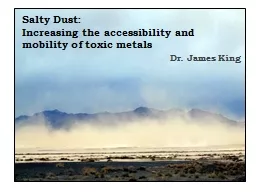

Increasing the accessibility and mobility of toxic metals Dr James King Acknowledgements Richard Reynolds Harland Goldstein Jim Yount George Breit Suzette Morman George Nikolich Jack Gillies Vic Etyemezian ID: 309894
Download Presentation The PPT/PDF document "Salty Dust:" is the property of its rightful owner. Permission is granted to download and print the materials on this web site for personal, non-commercial use only, and to display it on your personal computer provided you do not modify the materials and that you retain all copyright notices contained in the materials. By downloading content from our website, you accept the terms of this agreement.
Slide1
Salty Dust:
Increasing the accessibility and mobility of toxic metals
Dr.
James KingSlide2
AcknowledgementsRichard Reynolds, Harland Goldstein, Jim Yount, George
Breit, Suzette MormanGeorge Nikolich, Jack Gillies, Vic EtyemezianSlide3
Why salty dust?
Aral Sea dust storm
April 18 2003
NASA MODIS
Photo by W. Cox, GBUAPCD
Evaporite-mineral dust contain
elevated As, Cr, Cu,
Ni
,
Pb
,
Th
, U, SeNo current limits on inhalation of toxinsBioaccessibility of toxic metalsSpatial variability of metal content in dust vs. groundwater chemistryInfluences from climatic variability
Dust from Owens (dry) LakeSlide4
Types of Playas
WET
DRY
(Stone,
1956; Neal
,
1965; Rosen
, 1994)
Ground water is at or near the surface (< 4 m)
Ground water is far below the surface (> 4 m) or cannot interact with surfaceSlide5
Dust Emission MechanicsDirect entrainment
Highly dependent on surface conditionsGenerates relatively smaller amounts of dustSensitive to wind regime
F
=
Au
*
3 5
Saltation Bombardment
Dependent on sand supply conditions
Fetch effects are important
q = Bu*3Surface Roughness
Vegetation, rocks, and crusts can modify the efficiency of dust emission mechanicsSlide6
Playa Surface Characteristics
Relatively stable with time
Typically
very hard
Variable &
Dynamic
Soft – in areas of fluffy & puffy sediment
Hard – in areas of crust
Wet playa
Dry playa
Hard, compact surfacesSlide7
Playa Sediment Types
Wet Playa
Fluffy
sediment – very soft; abundant evaporite minerals produced continuously; high volume of pore space
Puffy sediment – soft, hummocky
surface; fewer
evaporite minerals.
Crusts – salts and carbonate
Dry Playa
Typically
compact clastic sediment (commonly
mud cracked)
Evaporite minerals deposited originally in lake bedsSlide8
Dust Emission from
Playas
Wet playa
Dry playa
Conditions may promote dust
emission. Efflorescent
salts in near-surface sediments
produce
mineral
fluff &
soft surfaces
Low levels of
dust
emission when sediment supply is limited and surface is undisturbed
Hard, compact surfaces
Franklin Playa
April 2005
Wet playa
Dry
playaSlide9
Field study & Monitoring siteFranklin Lake Playa, USA
Mojave Desert
Franklin Lake
Amargosa River
Carson Slough
Ash MeadowsSlide10
Quickbird
satellite images
0.6-m resolution
April 2006
Czarnecki
, J.B., 1997. USGS Water Supply Paper, 2377.
Ash Meadows
Carson Slough
Ash
Meadows:
0.7
1.5
16
90
Specific Conductivity (mS cm
-1
)
Spring Discharge:
a
60,000 m
3
day
-1
Evaporation:
b
22,800 m
3
day
-1Precipitation: 100mm yr -1 Pan Evap. 2500 mm yr -1aDudley & Larson, 1976; bCzarnecki & Stannard, 1997) Slide11
Groundwater Ion Content Trends
Franklin Playa
Carson Slough
Ash MeadowsSlide12
Groundwater Metal Trends
85
180
190
83
93
As (ppm)
As (ppm) predicted in anhydrous salts (Cl) by mass balance from evaporationSlide13
Trace Metal and Ion Content with Depth
As
U
Cl
SO
4
Franklin Playa Auger
Sediments
Evaporation Front:Slide14
Surface
Evaporation front
Water table
Groundwater
vapor generated
Evaporation
Metals move with water
Water vapor rises with few metals
Metals accumulate in residual water
Chloride concentrated
Sulfates precipitated, few metals
Thick evaporation zone
evaporation zone
Thin
evaporation zone
Evap.
front
Water table
Groundwater
Evaporation
Metals move with water
Sulfates, chlorides precipitated with metalsSlide15
Surface and Dust sediment collection
Bulk dust collection
Dust
Wind-tunnel
Tests
Assess the potential vulnerability
of surfaces to wind erosion
Simulated winds to ~ 20 m/s to measure PM
10
dust fluxSlide16
Salt Crust Arsenic Spatial Trends
As
SO
4
:
Cl
Ratio in ground waterSlide17
Mobility of
Sulfates
ground water
crust
dust
ground water
dust
dust
dust
ground water
ground water
crust
crust
crust
Fractionation increases sulfate in crust and dust
Sulfates are mobile
SO
4
& Cl increase in
groundwaterSlide18
Bioaccessibility of Toxic Metals
Extraction pH
Temp (C)
Time Mixing
control
method
Gastric
1.5
37 I hr Shaker in Enviro
Chamber
Intestinal 5.5 37 I hr Shaker inEnviro Chamber Lung 7.4 37 24 hr IncubatorPhysiologically based extractions in simulated biofluids
to assess
bioaccessibility
of
As, Cd, Cr,
Pb
, Mo,
Sb
, W Se, U, etc.Slide19
Uranium
Arsenic
Intestinal
Gastric
Lung
North
South
Extractions from dust in simulated
biofluidsSlide20
Extractions from dust in simulated
biofluids
Intestinal
Gastric
Lung
85
180
190
83
93
As (ppm)
As (ppm) predicted from ClSlide21
Summary on accessibility of toxic metalsExtractions from dust in simulated biofluids demonstrate that for both
Ar and U, the potential for concentrations exceeding current ingestion limits could be reachedFor these results there is no bias of the accessibility of Ar or U based on dust chemistry – this simplifies any prediction of other potential sources of toxic dustDifferences in the accessibility of Ar
and U exists between the three tested
biofluids
, with the intestinal
biofluid having the lowest ability to access the metalsSlide22
Summary of mobilitySulfate salts are the most mobile; easily precipitating from the groundwater and concentrating further when erodedToxic metals, in this case mainly As and U, are precipitated with the salts but mainly rely on the movement of chlorides to accumulate at the surface
The conceptual model proves that any history of a thin evaporation zone could lead to concentration of toxic metals near the surface if present in the groundwater and therefore groundwater chemistry alone is not a good predictor of the potential mobility and accessibilityFurther work is currently under way to model wind erosion emissions based on local climate and surface conditionsSlide23Slide24
PI-SWERL
Portable In-Situ Wind ERosion Laboratory